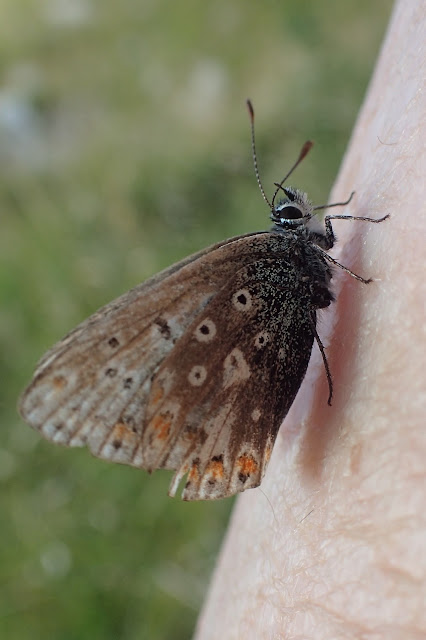Garden Privet (Ligustrum ovatum) is now in flower (or just finishing) in Settle (e.g. at Railway bridge near Victoria Hall). How is it different from Wild Privet (Ligustrum vulgare)?
Stace says of the Wild Privet: :1-year-old stems and panicle branches densely puberulous (i.e. with very short hairs) ; leaves lanceolate to oblanceolate, narrowly acute.
Garden privet: young stems and branches glabrous. leaves usually elliptic, acute to rounded at apex.
So, on Sat 10 Aug I set off to look for the one Wild Privet bush I know find out.. On the dry waterfall in Watlowes Valley.
And yes, the branches in the wild privet are puberulous
 |
| Ligustrum vulgare - Wild Privet It was not in flower - but then when I have noticed it before it has been in the early part of the flowering season (June), not August. |
As I started to descend from Comb Scar Down to Waltlowes I noticed this lovely patch of Welted Thistle Carduus crispus. Carduus species have simple hairs in the pappus (unlike Cirsium species - eg. Marsh Thistle (Cirsium palustre) and Creeping thistle (Cirsium repens)- thistles with heads of a similar size, and so confusable - but which have feathery pappus hairs).
Welted thistle has stems that are continuously spiny winged up to or nearly up to the capitula. . It grows in hedgerows, streams sides a,d rough ground especially on rich or basic soils. well this is rough and basic ground.
bit by bit I shall add more pictures to tell you more of my visit., and the other purple flowers and of distractions by butterflies, snails, fossils and of course lichens...
 |
| The Hypogymnia physodes lichen on the sign post |

 |
| The Clausilia sp snail on Caloplaca cirrochroa lichen |
 |
| Caloplaca cirrochroa |
 |
| A Northern Brown Argus butterfly I think (initially perched on a Sesleria caerulia grass flowerhead) |
 |
| A Northern Brown Argus butterfly I think |
 |
| Orpine - Hylotelephium (formerly Sedum) telephium This is a flower that is only just coming out on 10 August. https://plantatlas2020.org/atlas/2cd4p9h.7mm2n8 |
 |
| Orpine -Hylotelephium (Sedum) telephium |
 |
| Lepraria nivalis |








No comments:
Post a Comment